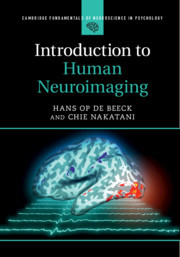Description
Introduction to Human Neuroimaging
Cambridge Fundamentals of Neuroscience in Psychology Series
Authors: Op de Beeck Hans, Nakatani Chie
An accessible primer for courses on human neuroimaging methods, with example research studies, color figures, and practice questions.
Language: English
Subject for Introduction to Human Neuroimaging:
Approximative price 67.54 €
In Print (Delivery period: 14 days).
Add to cart
Introduction to Human Neuroimaging
Publication date: 05-2019
368 p. · 17.4x24.7 cm · Paperback
Publication date: 05-2019
368 p. · 17.4x24.7 cm · Paperback
Approximative price 127.70 €
In Print (Delivery period: 14 days).
Add to cart
Introduction to Human Neuroimaging
Publication date: 04-2019
350 p. · Hardback
Publication date: 04-2019
350 p. · Hardback
Description
/li>Contents
/li>Biography
/li>
Developed specifically for students in the behavioral and brain sciences, this is the only textbook that provides an accessible and practical overview of the range of human neuroimaging techniques. Methods covered include functional and structural magnetic resonance imaging, positron emission tomography, electroencephalography, magnetoencephalography, multimodal imaging, and various brain stimulation methods. Experimental design, image processing, and statistical inference are also addressed, with chapters for both basic and more advanced data analyses. Key concepts are illustrated through research studies on the relationship between brain and behavior, and practice questions are included throughout to test knowledge and aid self-study. Offering just the right amount of detail for understanding how major imaging techniques can be applied to answer neuroscientific questions, and the practical skills needed for future research, this is an essential text for advanced undergraduate and graduate students in psychology, neuroscience, and cognitive science programs taking introductory courses on human neuroimaging.
1. Introduction and overview; Part I. Structural Neuroimaging: 2. The physics behind magnetic resonance imaging; 3. Structural imaging methods; Part II. Hemodynamic Neuroimaging: 4. Hemodynamic imaging methods; 5. Designing an hemodynamic imaging experiment; 6. Image processing; 7. Basic statistical analysis; 8. Advanced statistical analysis; Part III. Electrophysiological Neuroimaging: 9. Electromagnetic field of the brain; 10. Electroencephalography and magnetoencephalography; 11. Basic analysis of electrophysiological signals; 12. Advanced data analysis; Part IV. Complementary Methods: 13. Multi-modal imaging; 14. Causal methods to modulate brain activity.
Hans Op de Beeck is a Professor in the Faculty of Psychology and Educational Sciences at the Katholieke Universiteit Leuven, Belgium (KU Leuven), and a member of the Laboratory of Biological Psychology (LBP) and the Brain and Cognition Research Unit. He is the recipient of a long-term fellowship and a career development award from the international Human Frontier Science Program (HFSP), an honorary fellowship of the Belgian-American Educational Foundation (BAEF), the KU Leuven Research Council Award in 2008, and the 2012 laureate of the Royal Flemish Academy of Belgium (KVAB).
Chie Nakatani is a Postdoctoral Fellow in the Brain and Cognition Research Unit at the Katholieke Universiteit Leuven, Belgium, having previously worked as a Research Scientist at the Laboratory for Perceptual Dynamics, RIKEN Brain Science Institute, Japan. She has a range of research and teaching experience with a particular focus on electroencephalography.
Chie Nakatani is a Postdoctoral Fellow in the Brain and Cognition Research Unit at the Katholieke Universiteit Leuven, Belgium, having previously worked as a Research Scientist at the Laboratory for Perceptual Dynamics, RIKEN Brain Science Institute, Japan. She has a range of research and teaching experience with a particular focus on electroencephalography.
© 2024 LAVOISIER S.A.S.
These books may interest you

The Oxford Handbook of Functional Brain Imaging in Neuropsychology and Cognitive Neurosciences 195.39 €

Neuroimaging of Mental ImageryA Special Issue of the European Journal of Cognitive Psychology 61.25 €

Neuroimaging IIClinical Applications 210.99 €

